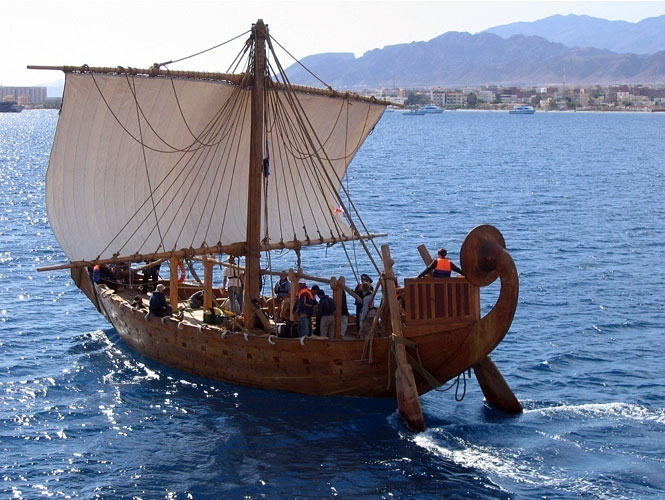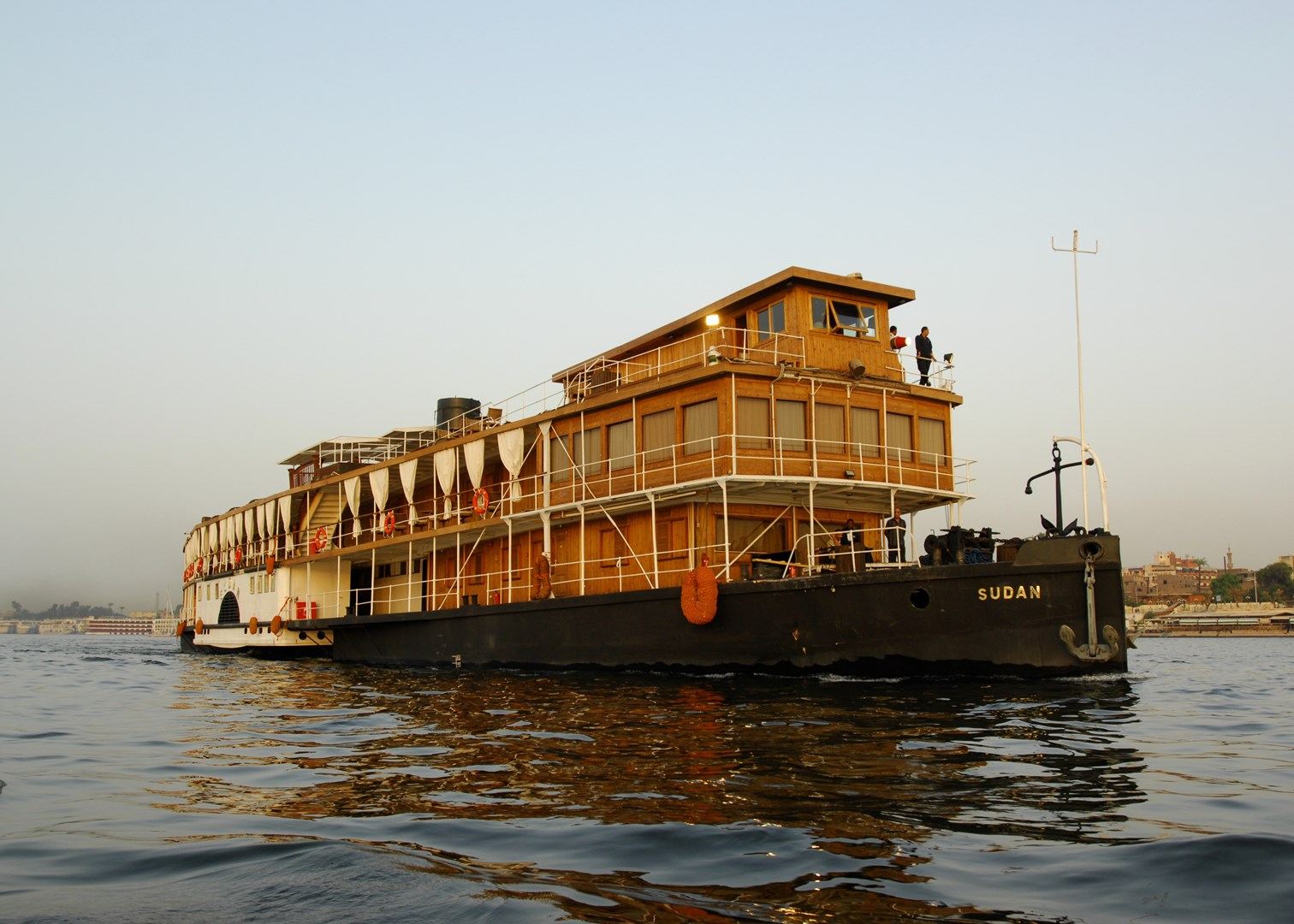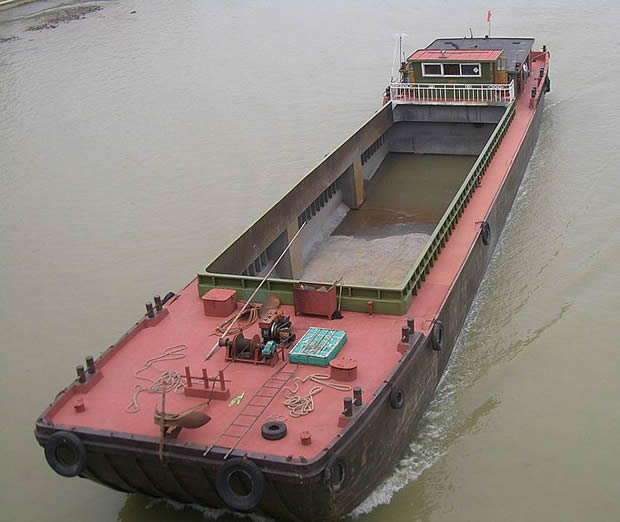 |
| Ancient Egyptian boat replica |
For thousands of years humans have used freshwater waterways to ship food, building materials, and goods between regions. A freshwater waterway is any low-salt body of water, such as a river, lake, or man-made canal on which ships may travel. The need for freshwater for drinking and irrigation (watering crops) led most early civilizations to develop along rivers.
Shipping on freshwater waterways continues to be a reliable and important way to transport goods. Shipping goods over waterways is slower than other forms of shipping, yet it is less expensive and allows larger loads of cargo. Therefore many heavy raw materials such as coal, oil, timber, food products, and metal are often shipped over water. Many modern cities are still located along rivers and lakes.
Shipping in ancient Egypt
The ancient Egyptians (3000 b.c.e.-30 c.e.) depended upon the Nile River for their survival. The Nile River was the only source of drinking water for most Egyptians. Its yearly floods deposited silt (fine particles smaller than sand) that fertilized Egyptians crops. The Egyptians also used the Nile as their main highway, connecting Upper Egypt in the south with Lower Egypt in the north.
  |
Egyptian boats relied on wind or oars to travel on the Nile. Generally, boats traveled south by wind, as the wind usually blew from the north. Since the Nile flows from south to north, most ships would follow the flow of the river and drift with the current or row north.
The Egyptians relied on barges to transport large amounts of goods. A barge is a large, usually flat ship that can carry heavy cargo. Egypt depended on barges to move building materials such as stone from places where it was mined and cut in the south to the major cities such as Cairo and Alexandria in the north. Without transporting goods on the Nile, the Egyptians would not have been able to construct the pyramids or construct large cities.
Propulsion systems
The ancient Greeks, Romans, Phoenicians, and numerous European civilizations also relied on freshwater shipping to move goods. Like the Egyptians, all of these civilizations relied on sails or oars for propulsion. Propulsion is the means by which a ship moves through the water. Sometimes animals, such as horses or mules, walked along the shore and pulled a ship along a slow-moving river or canal using a rope.
 |
| Steam propulsion ships |
Over the last few centuries however, humans have developed new forms of propulsion. In the early nineteenth century, the first steamships were developed. Steam propulsion ships, whose power came from boilers that provided steam under pressure to turn turbines or paddlewheels, proved useful on freshwater waterways such as rivers and lakes, which were poorly suited for sailboats.
Inland waterways (water bodies away from the coast, such as rivers) often lacked enough wind, or wind blowing in the proper direction, to propel large cargo ships against the current of the river. The invention of diesel engines in the early twentieth century led to diesel-powered ships that replaced steamboats because diesel engines allowed cheaper shipping without the dangers of pressurized steam.
With these new forms of propulsion goods can be shipped on freshwater waterways faster, cheaper, and in greater quantity. For example, in the United States, over 700 million tons (635 million metric tons) of cargo are shipped on freshwater waterways every year. Most of this cargo is carried on freshwater waterways by barges.
 |
| Modern barge |
Modern barges are large, flat boats that are often joined together like railroad cars. A typical string of about fifteen barges is pulled or pushed by small, powerful tugboats, or tugs. A single barge can carry as much cargo as sixty large truck containers or fifteen railroad cars.
Types of freshwater waterways
Major river systems are the most common form of freshwater waterways used for shipping. A river system is made up of a major river and all of its tributaries, the smaller rivers or creeks that feed into the main river.
Lake systems are also often used to ship goods. In the United States, for example, there are two main freshwater systems that are used for shipping, the Mississippi-Missouri river system and the Great Lakes-St. Lawrence River system. The Mississippi-Missouri river system allows shipping in the Midwest and Southeast.
The Great Lakes-St. Lawrence River system serves the Midwest and northeastern United States and part of eastern Canada. Over 75% of all materials shipped over freshwater waterways in the United States are shipped on either the Mississippi-Missouri river system or the Great Lakes-St. Lawrence River system.
Other smaller river systems are also used for shipping in the United States. The Ohio River system in the Midwest, the Tennessee River system in the Southeast, the Colorado River system in the West, and the Columbia River in the Northwest are important for shipping. There are also major river systems in other parts of the world that are used for shipping: the Danube, Rhine, and Volga river systems in Europe; the Nile in Africa; the Amazon in South America; and the Yangtze in China.
Canals
What happens when river systems do not quite reach important places? Other forms of shipping, such as trains, airplanes, or trucks may be used, but the best solution may be the construction of a canal. A canal is a man-made deep and wide waterway through which ships may travel. A canal can connect one river or lake with another to allow ships to travel farther inland to reach major cities.
The bodies of water that a canal links may be at different elevations (heights) above sea level and therefore, not navigable for ships. Therefore the water level in a canal is usually not the same from one end of the canal to the other. To solve this problem and allow the passage of ships through the canal, a series of gates and locks must be constructed along the course of the canal.
A lock is a large area with gates at each end that raises or lowers a ship to areas of the canal that have different water levels. Similar to an elevator with door on opposite sides, locks are an essential part of any canal.
When a ship is going from an area of lower water level to an area of higher water level the ship enters the lock and the gate behind it closes. Water is pumped into the lock to raise the ship. When the water level inside the lock is at the same level as the higher water level in the canal the front gate opens and the ship continues its journey on the canal.
When a ship is moving from an area of higher water level in the canal to an area of lower water level, then the process works in reverse. Once the ship enters the lock, water is pumped out of the lock to lower the water level until it matches the lower level on the other side. Once the water level is the same the gate opens and the ship continues its voyage.
Problems with shipping on freshwater waterways
One disadvantage of shipping on freshwater is that it is much slower than other forms of shipping such as trucks, railroads, or airplanes. Also, freshwater waterways do not reach everywhere that goods are needed. The construction of canals can extend freshwater waterways to some, but not all areas.
These locations must ship their goods to and from the nearest port (seaside) city by another means of shipping. A third disadvantage is that like roads, waterways must be maintained or they fall into disrepair. Tree limbs, trash, and soil clog waterways so that a ship cannot pass. Freshwater waterways must be dredged occasionally to remove buildup on the bottom of the waterway and around bridges and shores.
Dredging is a process where a ship drags a hook or grate along the bottom of a waterway in order to remove the accumulated silt and mud. Dredging makes freshwater waterways more navigable (able for ships and barges to move through the waterway) by deepening the waterway and sometimes helping to smooth areas with strong currents.

